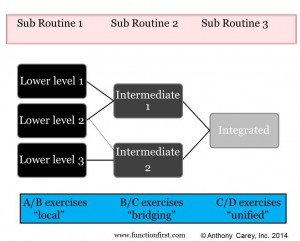More than 5 years ago I wrote a blog post on Exercise Sequencing vs . Exercise Progressions. Sequencing of exercises is a critical part of how we design our corrective exercise programs and instrumental in what we teach in the Pain Free Movement Specialist.
From the feedback that I’ve received in the 18 years or so that I’ve been teaching principles of the Function First Approach-programming is always the most challenging aspect. Too many fitness pros go down one of two “rabbit holes”:
1. Programs built around giving symptomatic relief which is clearly outside of our scope of practice. For example, the client whose knee is painful is given all “corrective” exercises focused on the knee. The inherent risk in this for fitness pros is that you have indirectly (and possibly unintentionally) made a medical decision because your intervention is based on pathology you have determined existed. Unless you are working in a post rehab capacity (different paradigm) with directives from a licensed professional you are treading on thin ice.
2. Programs that follow a linear progression=”if this than that” or “first this than that” do not address nor acknowledge the diversity of the human body or human experience. Examples might be mobility always before stability or activate than integrate.
If working with the human body was that easy, programming from either of those rabbit holes would work every time. I wish it were that easy. We understand that programming, especially for the chronic pain client is difficult. Biomechanics is a piece of the pie and strategic movement is critical to success. And as movement professionals, that is our tool of the trade. But there is so much to the choice of the tools and the delivery of those tools that make or break a successful program for the chronic pain client.

Movement is more than motion for the pain sufferer. It should be strategic, efficient, non-provocative & confidence building.
The follow up programming is no different. We change our client’s exercise program every two weeks. The major objectives do not change, but the variability of the input via the exercises is a critical piece of the process toward meeting those objectives. The role of variability in the corrective exercise domain cannot be underestimated. When exercises are of limited biomechanical, neurological and physiological demand for the purpose of influencing the quality of motion, variable learning opportunities are necessary. Waiting for completele mastery of any exercise may actually slow the process toward the long term goal.
The real goal is not to get better at exercise “x” or “y” or to strengthen this or lengthen that. No. The real goal is to assist the client to move better and be prepared for as much physical demand to the body that they may encounter.
There is a process to this and understanding the pain experience for the client is a necessity. Marrying the role of biomechanics with the neuroscience and psychology of pain are pillars of the Pain Free Movement Specialist curriculum. We can teach you this if you have the desire to help those that have not gotten help before. Would you like to take the journey with us and become a resource to people from around the world-not just your neighborhood?
This journey is not for everyone and we understand this. Because this is not just a curriculum that teaches you how to write an exercise program, it is a curriculum that moves you through stages of in-depth understanding of how to best serve this incredibly diverse yet underserved population. Everyone should be given the chance to realize a life void of pain and you can help facilitate that for them.
Contact us to see if you are right for this curriculum. Email education@functionfirst.com or kmurray@functionfirst.com or call 619.285.9218.
Cheers for the PFMS
My corrective exercise abilities as a trainer are profoundly different after learning the Function First approach to Corrective Exercise. The Pain Free Movement Specialist Certification Program takes you on in-depth journey into the field of Corrective Exercise and Pain Science utilizing sound biomechanics, principles and strategies to address your clients needs. The real-world tangible benefits from this program were evident immediately as I not only became confident but also proficient and successful at working with my clients suffering from various forms of pain.
What I particularly enjoyed about this program was the immediate benefit I experienced as a result of the curriculum. Not only was I able and had the confidence to work with and assess my clients, I was also armed with effective and proven exercise strategies and protocols. I have seen the benefit of these skills and my clients have too!
I highly recommend the Pain Free Movement Specialist Certification for anyone looking to set themselves apart from the rest, who has a desire to learn proven and successful strategies and who wants to master the intricate in’s and out’s of both Corrective Exercise and Pain Science!
Reyci Martorell
Tags: Anthony Carey, corrective exercise, pain-free movement specialist, program design
As a chronic pain sufferer (since 2010), where do I find a qualified practitioner to help me back to pain free movement?
I understand fitness to a certain extent – qualified exercise instructor since mid 1980s and try to keep up with current research.
Complicated as I am currently living in Tanzania therefore possibly looking for an online resource / practitioner.
Hi Maggie. We currently work with clients from around the world via Skype and video. We do a 30 minute consult via Skye and then design a program for you. We film ourselves doing your program and upload for private viewing on Youtube. This is accompanied by a printout to follow offline as well. We have had great success with this process and definitely provides the best possible personalization from a distance.